“I have considered the days of old, the years of ancient times.”
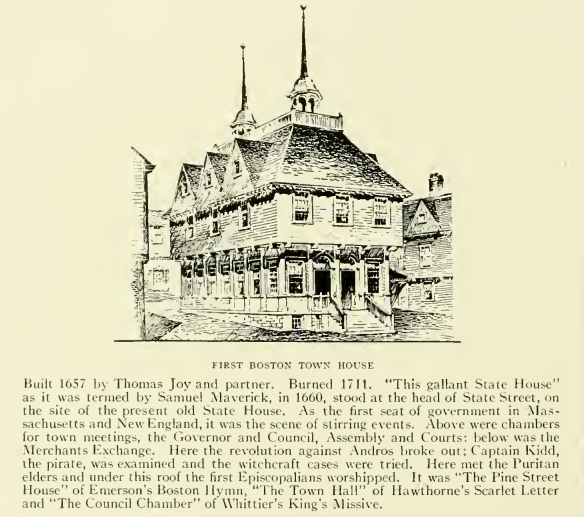
Joy: History of a Name
The name of Joy has been borne with honorable distinction by families in England and Ireland for at least five centuries. There is reason to believe that the name was derived from the locality Jouy, in Normandy, and may have reached England in the form “de Jouy.” It has undergone many modifications, in some of which its identity disappears, as it passes from Joy to Jay through such forms as Joye, Joie, Jaie, Jaye, and even Gee. The earliest of the name in England of whom we have information is William, who was vicar of Tibenham, in Norfolk, in 1395. In 1441 one Thomas Joye was rector of Fritton, in the same shire. In the list of Irish Archbishops of Tuam we find William Joy in 1487. George Joye, a fellow of Peterhouse College, Cambridge (1517), was one of the most learned and devoted leaders of the Protestant Reformation in England, and his fame is associated with Tyndale’s in the translation of the Bible into the English tongue. Among the English colonists of Ulster about 1597 was a Captain Thomas Joy, among whose descendants are Francis Joy, the pioneer paper maker of Ireland and founder of the Belfast Newsletter; Robert Joy, the promoter of the Ulster cotton manufactures; and Baron Henry Joy, attorney-general, whose statue stands in the Hall of the Four Courts, Dublin. George W. Joy, artist and marksman, and Albert Bruce Joy, the sculptor, are of this branch, and the roll of English painters includes the names of three other Joys of considerable merit. Norfolk County has been for five hundred years the seat of a family of Joy.
Thomas Joy, 1610-1678
(Maternal 11th Great-Grandfather)
Records show a 25 year old Thomas Joy sailed from London, England in late 1635, on the ship “Constance.”

Thomas Joy first appears in Boston records in 1636 after he purchased property from Robert Turner under condition of inoffensive carriage, or being a good citizen. Thomas Joy was a carpenter and architect. In 1637 Thomas married Joan Gallop, daughter of Capt. John and Christabel Gallop of Boston.
Early town records, maps, and deeds show Thomas Joy’s holdings and transfers of real estate. He owned several tracts of land on the east side of the peninsula in the “Great Cove” which included Bendall’s Dock, or the Town Dock, the principal lading place for vessels, and the center of the town’s merchandizing.

It was said that the “cove lots” were granted to “the principal men of the town,” and gives a list of eighteen owners of these “meersteads” in the order of their possessions, beginning at the north. Thomas Joy’s is the second name, and the sixth is that of his father-in-law, John Gallop. On Thomas Joy’s half acre by the sea were two houses, both of which he doubtless built and in one of which he dwelt. His acre of ground farther inland became in later years the “court end” of the town. The mansions of Governor Hutchinson and
Sir Charles Henry Frankland, and the dwelling of Paul Revere were
built upon it, and on its border was the historic meetinghouse of Increase
and Cotton Mather. A third plot, perhaps the most valuable of all,
was in Bendall’s Cove, not far from and perhaps including the sites of
Faneuil Hall and the “old feather store.”

The Boston Book of Possessions, (aka the Doomsday Book) lists early Boston lands and landowners. It details two lots belonging to Thomas Joy.

At a town meeting in 1642 liberty is granted to Thomas Joy to set up a house over his cellar by the waterside near his dwelling house in the Millfield, keeping open a passage of 6 foot in breadth between houses. Evidently Thomas didn’t get the project done. In 1644 he was ordered, under penalty, to make a safe passage over his cellar in the high way, by the water side, in the Millfield. Soon, because of his continued neglect of the town’s order, constables were appointed to require and receive of Thomas Joy, or to levy by distress upon his goods, for the towns use.
In 1646 Thomas Joy went to Hingham, about 17 miles southeast of Boston, to enlarge a grist mill, built in 1643, at the town cove. He also built an adjacent sawmill.
The 1643 mill was dismantled around 1692 and rebuilt several hundred feet to the northeast. In 1797 the mill was again taken down and a new mill built in the same spot. The working mill survived for 300 years and was the oldest working tidal mill in the United States when its mill stones stopped grinding c1943. It’s been written that the millstones are at the Hingham Historical Society’s Old Ordinary on Lincoln Street.

In 1646 Thomas Joy became involved in the famous “Dr. Child’s Memorial,” so named from the prominence of one Dr. Robert Child in its origination and support. It was a protest against certain illiberal customs of the period and particularly against the narrow policy of the colonial government which since 1631 had restricted the right of suffrage to the members of the local Puritan churches-thus excluding more than three fourths of the adult male population from any participation in public affairs.
Thomas Joy entered into the plea for enlarged liberty and supported the movement as a representative of the non-freemen. The signers were not numerous, and their prayer was denied by Gov. John Winthrop and his associates. When it became known that the petitioners intended to renew their claims before the British Parliament, the magistrates put forth all their energy to prevent it . The night before the departure of the ship which was to carry the documents to England, the authorities raided the study of one of the signers, where they found evidence which led to the arrest of several persons. The petition itself was safely conveyed to London, where it gained much attention but was soon forgotten in the tumult of the First English Civil War.
In Boston some of the petitioners were thrown into prison, others were heavily fined, and most of them left the colony forever. Regarding Thomas Joy and according to Winthrop’s History of New England, Joy was concerned in getting “hands” to the petition which was to be sent to England, and when search was made of Mr. Dand’s study, he ” began to be very busy” and challenged the authority of the marshal. He was arrested for this and ” kept in irons four or five days,” when he submitted and was released on bail.
“There was also one Thomas Joy, a young fellow, a carpenter, whom they had employed to get hands to the petition. He began to be very busy and would know of the marshal when he went to search Dand’s study, if his warrant were in the King’s name, etc. He was laid hold on and kept in irons about four or five days, and then he humbled himself, confessed what he knew, and blamed himself for meddling in matters belonging not to him, and blessed God for those irons upon his legs, hoping they should do him good while he lived. So he was let out upon reasonable bail.” – From Winthrop’s History of New England, vol. ii , pp. 293, 294.
“Thomas Joy was put in irons for merely circulating a remonstrance to the government in England against certain obnoxious proceedings of the government in Boston.” -Aaron Hobart, in a note to his History of Abington, Mass. (1839) , p. 22.
“Thomas Joy was arrested as a too ardent lover of liberty, yet is called a young fellow by Governor Winthrop. Though Joy was at this time thirty-five years of age Winthrop was nearly sixty, a fact which may readily account for his use of the term a young fellow.” – Savage, in Gen. Dict. of N. E., says in vol. ii, p. 573.
Thomas Joy Moves to Hingham
In 1648 Thomas Joy, perhaps realizing that he could scarcely expect to prosper under the frown of Boston authorities, moved his family to Hingham. There he bought a dwelling, a farm and mill. It was suggested that in Hingham Thomas Joy could “enjoy more sympathy of neighbors.” Hingham folks were noted for their tolerance in religious matters and their independence in politics. And, it is believed that Thomas was a native of Norfolk, England, like most of the Hingham settlers. He established permanent interests in Hingham, but still maintained a connection with Boston, including continued ownership of his properties there.
Thomas Joy struggled in Hingham. The colony was not growing at the pace of Boston, affording less opportunity. He moved some of his Boston property around to supplement the needs of his growing family. Due to continued persecution by the colonial authorities and the fear of fines and confiscation he placed his entire estate in the hands of trustees for the protection of his family.
In 1648 Thomas Joy, of Hingham, “acknowledges his indebtedness to Thomas Savage of Boston and mortgages his house situated near the new Meeting House in Boston with the garden & ground there to belonging.”
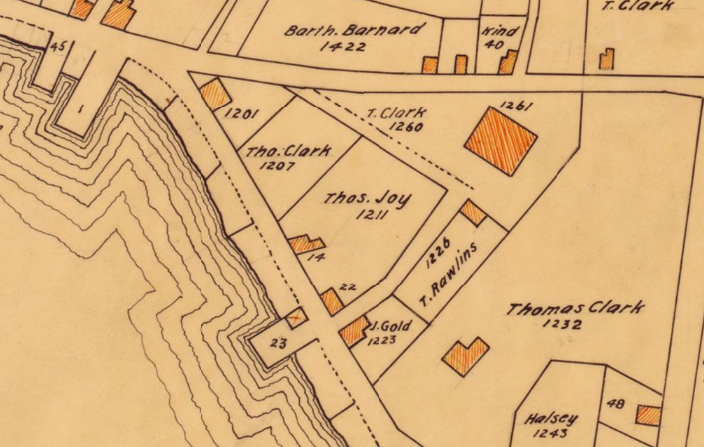
In 1649 Thomas Joy “conveyed to his father-in-law, John Gallop, and Edmund Jackson, their heirs and assigns, as feoffees in trust, all his houses, mills, and lands in Hingham and Boston”
Thomas Joy’s active participation in the business and social affairs of the capital was evidently fully resumed by the year 1656, but it is proper to mention in this connection several transactions of a later date in which he and his wife unite to convey portions of the land in Boston. As the deeds make no mention of encumbrances and were made in a season of much prosperity, they show the success with which his property was held until a judicious time for sale. Several of his transfers were not recorded.
“Twenty acres upon ye * highwaye that goeth to Marblehead ” were conveyed in 1661 by ” Thomas Joy of Boston,” to Captain Thomas Marshall, ofLynn, according to a copy ofa deed in the Suffolk Court Files. But the first recorded conveyance of Boston land was in 1664, † when ” Thomas Joy of Boston” granted to Thomas Walker, a brickmaker, for ” Sixty & five pounds by the value thereof in money & other Currant pay in New England, ” ” a Peece or Parcell of land ” which ” butteth on the highway South Easterly & from thenc to runn downe towards the Pond North Westerly,” ” wth the frame of an house on Part of the said land.”
Back in Boston
Thomas Joy had never wholly relinquished his business interests in Boston. It was the home of his wife’s family and their children who were born in Hingham, were taken to Boston to receive baptism in the First Church. By 1656 political wounds had healed and time had liberalized the views of the clergy.
Winthrop died in 1649, and the Rev. John Cotton in 1652. Thomas Joy was again doing business in Boston and welcomed back into social affairs. In 1659 he was appointed with two others to survey the mill bridge and determine whether the foundation and timber work were satisfactory.
The Town House
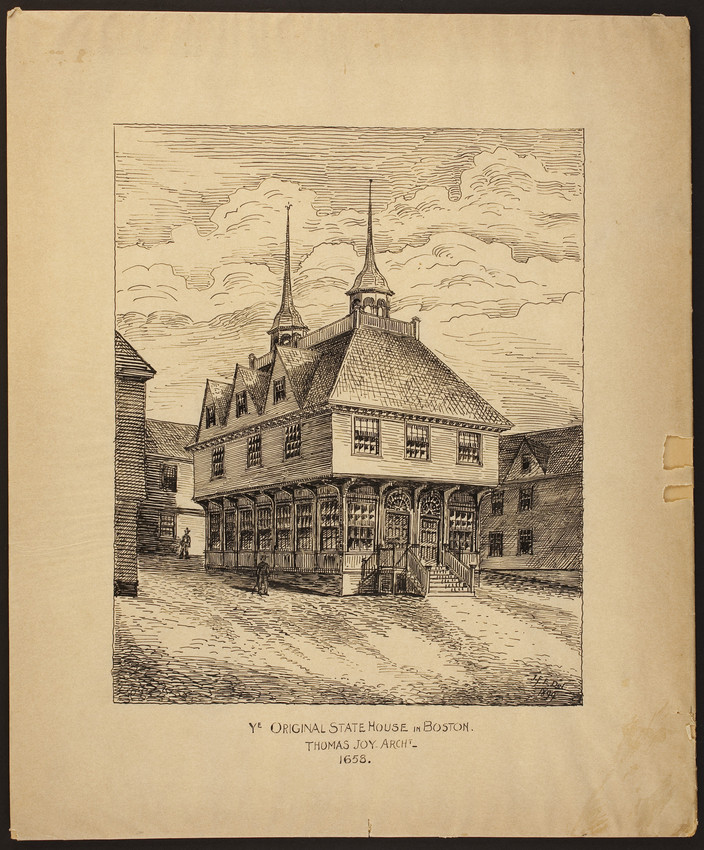
The need of a Town House in Boston was felt by all the citizens, but they were unable to fund the expense by general taxation. In the meantime, the meetinghouse was used for worship and town and colony affairs. In March of 1656 Robert Keayne, a wealthy merchant died and left £300 in his will for the construction of a marketplace and Town House. Townspeople eventually doubled that sum. The site chosen for the new Town House was the plot of land where today’s Old State House stands.
On August 1, 1657, the town’s building committee gave the contract of designing and building the Town House to Thomas Joy and Bartholomew Bernad. The project was completed in the Spring of 1658. Various sketches of the Town House exist.
Authors note: For a very detailed description of the Town House see: The Story of the Old Boston Town House, 1658-1711 By Josiah Henry Benton (1908)
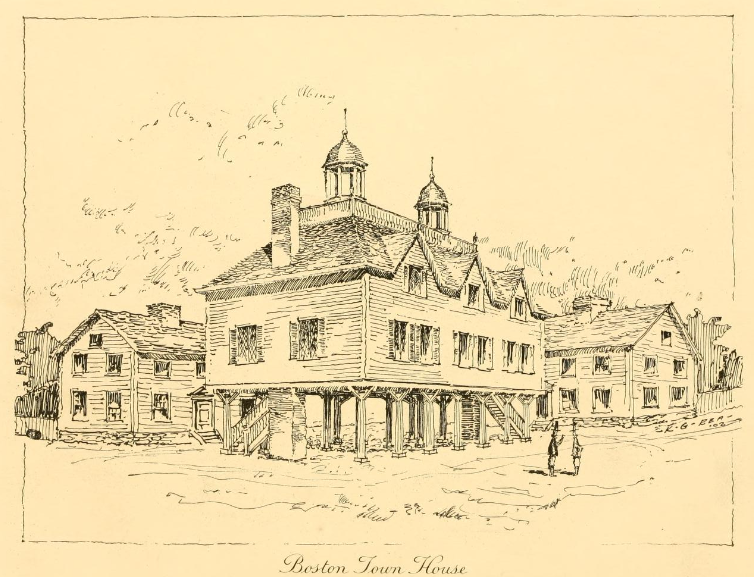
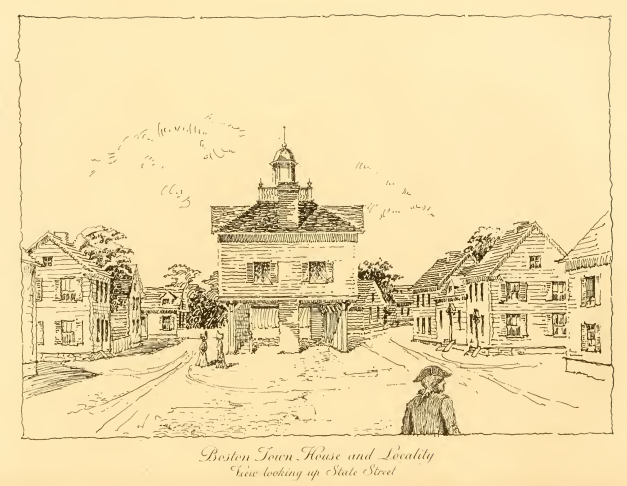
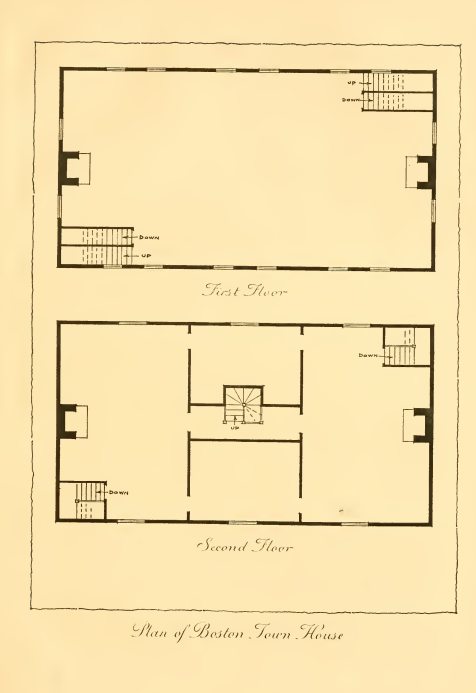
Boston Artillery Company
In 1658 Thomas Joy became a member of the Boston Artillery Company, now the famous “Ancient and Honorables.” The Ancient and Honorable Artillery Company of Massachusetts is the oldest chartered military organization in the western hemisphere. Its charter was granted in March 1638 by the General Court of Massachusetts Bay and signed by Governor John Winthrop.
Freeman
In 1665 Thomas Joy was admitted “Freeman” of the Massachusetts Bay Colony.
In 1665 it is ordered that “Thomas, in consideration of a piece of ground butting upon the new Meeting House to the North as his fence now stands, the said Thomas Joy is freed from all rates during his & wife natural life &
in silver besides.”
Records show that from 1669 through 1676 Thomas Joy began selling, and passing to his children, various pieces of property around Boston and Hingham. In some cases selling was motivated by progress in the Boston colony, such as the building of “high ways” or widening of streets. In other cases land was sold due to structures being laid waste by fire.
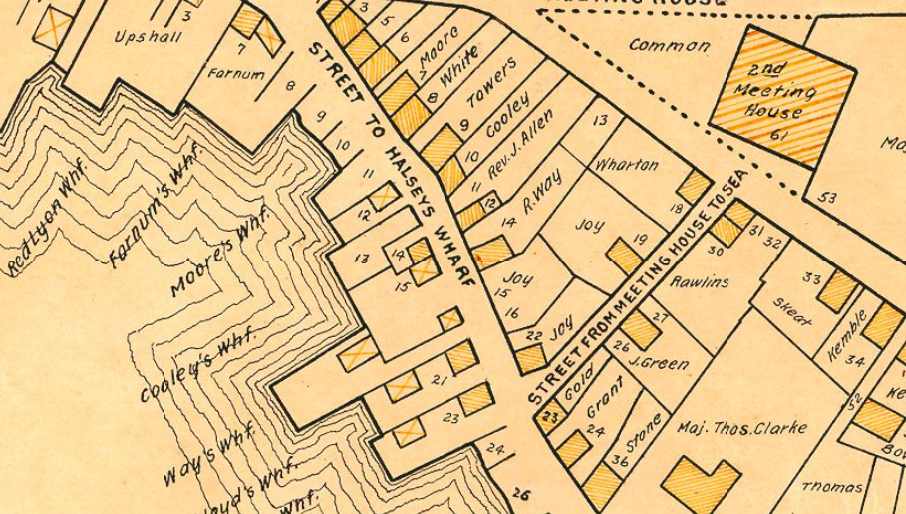
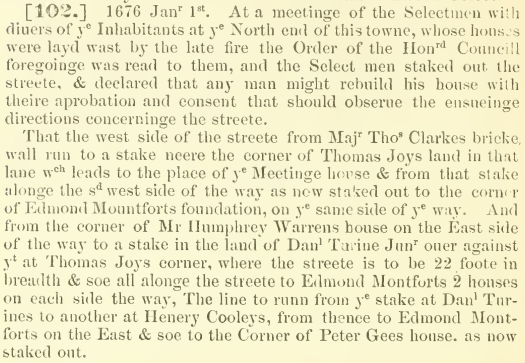
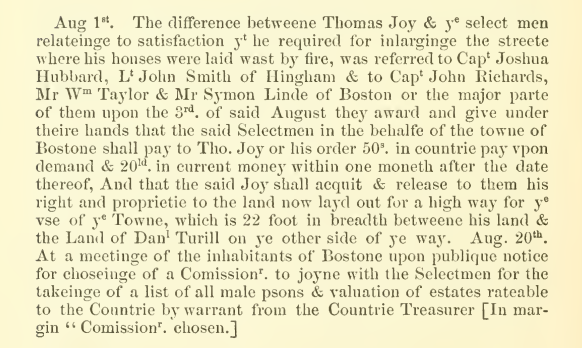
The Death of Thomas Joy
Thomas Joy died on October 21, 1678 (age 68). His wife Joan Gallop Joy died March 20, 1691 (age 72). Both are buried in the Hingham Cemetery, a large colonial-era graveyard located behind the The Old Ship Church (also known as the Old Ship Meetinghouse, built 1681).
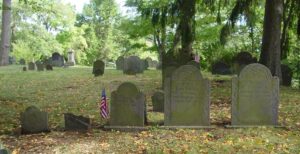
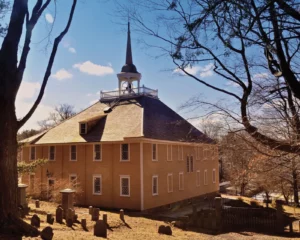
Sign of the Ship, or What Became of the Joy Property on North Street?
The original possession of Thomas Joy, who sold to Henry Fane, and Fane to Richard Way in 1659-60, Thomas Kellond 1777, Robert Bronsdon 1678-79, William Clarke 1707-08, Joseph Glidden 1728, and his heirs to John Ballard 1781. In 1789 John Ballard was innkeeper here. The Executor of Ballard conveys to John Page, and Page to George R. Cushing of Hingham in 1797. In 1798 it was a wooden building, three stories, twenty-nine windows, value $1850, and occupied by Ebenezer Knowlton, Ziba French, and John Daniels.

Since the days of Thomas Joy, Boston transformed from a small hilly peninsula less than 800 acres wide to a wide, flat landmass consisting of 89 square miles. The former land remains, albeit without the hills. Those were cut down to fill in ponds and push out the shoreline.
Authors note: See History of the Boston Landfill Project: How Boston Lost Its Hills for a detailed description of the transformation.
Descendants of Thomas Joy Leading to Shirley Joy
Joseph Joy (1645-1697) & Mary Prince (1649-1726)
Joseph, the first to wed, was a substantial builder and farmer at Hingham. He is buried at Hingham Cemetery. Mary was the daughter of John Prince and Margaret (Skillings) Prince.
Joseph Joy (Jr) (1668-1716) & Elizabeth Andrews (1665-1743)
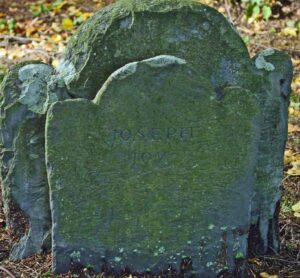
Joseph Joy Jr was a constable. In February 1708-9 he, along with others, signed testimonial to the worthy character of Mehitable Warren, accused of witchcraft. The Joseph Joy family lived on Main Street in Hingham, nearly opposite Winter Street. He and his wife are buried in the Hingham Cemetery. His inscription reads “Here Lyes Ye Body of Joseph Joy Died April Ye 29 1716 in The 48th Year of his Age.”
David Joy (1693-1739) & Ruth Ford (1698-1772)

David was born February 28, 1693-4. He was married to Ruth Ford, of Pembroke, Massachusetts. He moved from Hingham to Rehoboth, Massachusetts about 1720. Several of his children settled in Vermont. He is buried at the Palmer River Churchyard Cemetery.
Benjamin Joy (1719-1810) & Sarah S Cummings (1721-1803)
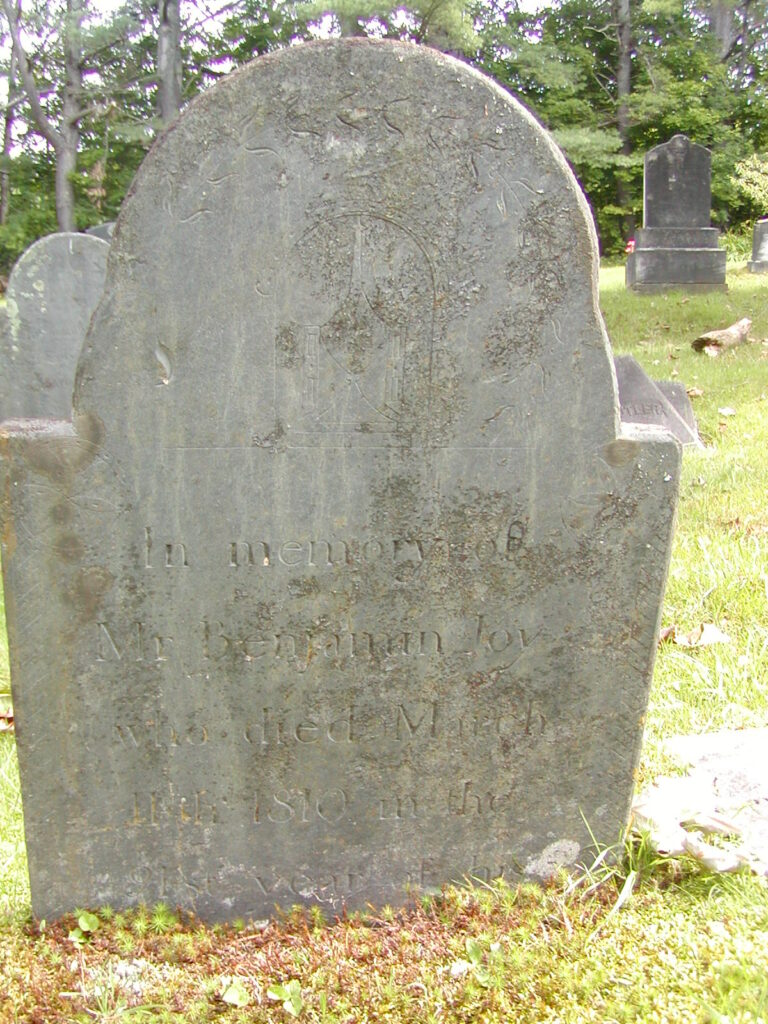
Benjamin was born May 20, 1719. On June 10, 1740, at the age of 21, he married Sarah Cummings at Rehoboth, Massachusetts Colony. They had at least eleven children. Sarah died at 81 and Benjamin at 90. They had been married 63 years. They are buried in Moulton-Thompson Cemetery Meriden, New Hampshire.
Ephraim Joy (1742-1777) & Elizabeth Pool (1747-1836)

PVT Ephraim Joy joined the New Hampshire Militia in 1777 at Cornish NH. He was part of Hobart’s Regiment during the Revolutionary War and was killed in the Battle at Bennington. Information suggests that Ephraim Joy was buried possibly in either Plainfield or Cornish NH, but a marked grave has not been located.
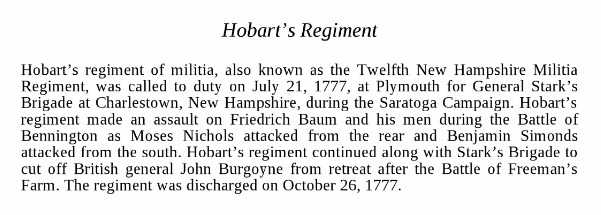
Ephraim Joy (Jr) (1774-1856) & Eunice Freeman (1788-1862)

Ephraim Joy Jr was born February 27, 1774 and married on December 28, 1797 at Plainfield, Cheshire, NH. It’s said he was a carpenter and prominent in the settlement of Southington, Ohio. Ephraim volunteered for the Ohio Militia in the War of 1812. He is buried at Joy Cemetery Southington Township, Ohio
David Joy (1820-1899) & Sarah C Williams (1818-1882)
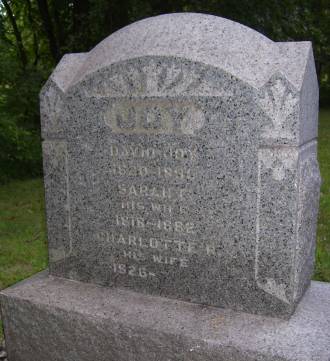
David Joy is buried at Joy Cemetery, Southington Township, Ohio.
Hubbard Joy (1845-1930) & Harmony T Foot (1851-?)
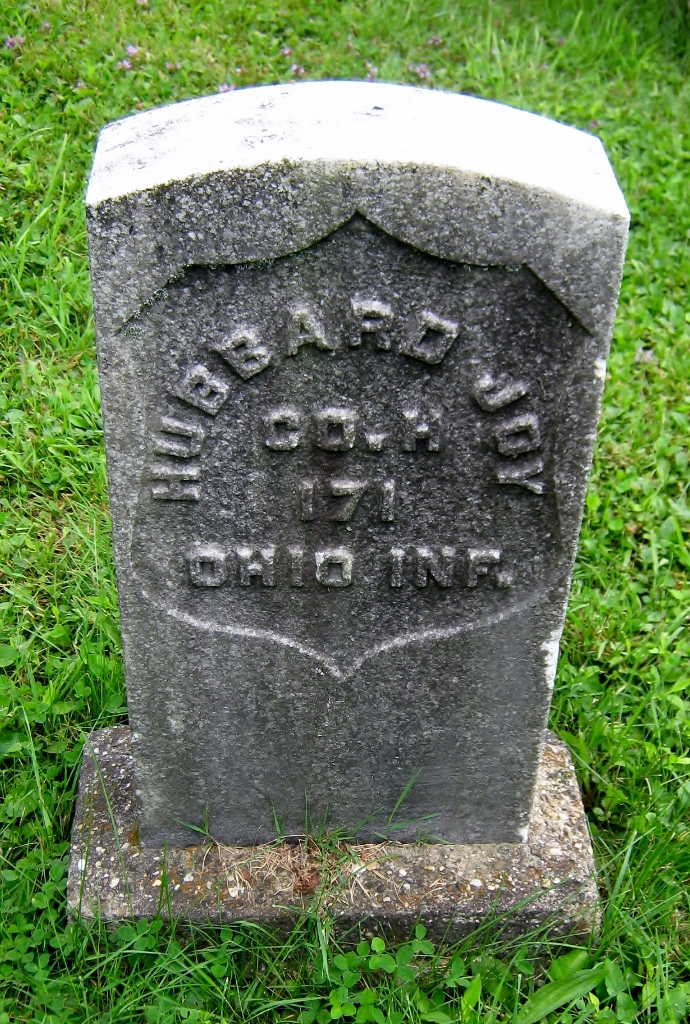
Hubbard Joy was born June 9, 1845 in Southington, Ohio. He was a rural mail carrier, and a Civil War veteran, part of Company H, 171st Ohio Volunteer Infantry. He died January 18, 1930 in Osceola, Florida at age 84. He is buried at Hillside Cemetery, West Farmington, Ohio.
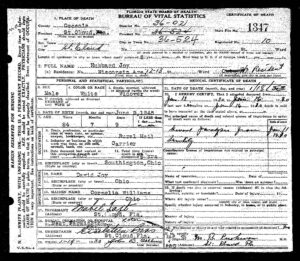
Erwin H Joy (1874-1957) & Gertrude E Fuller (1872-1945)
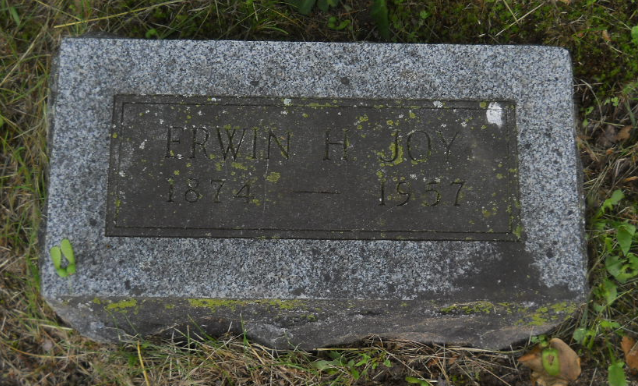
Shirley E Joy (1893-1962) & Lenna Belle Kidder (1904-1980)
(Maternal Great-Grandparents)
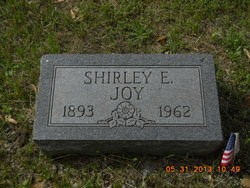
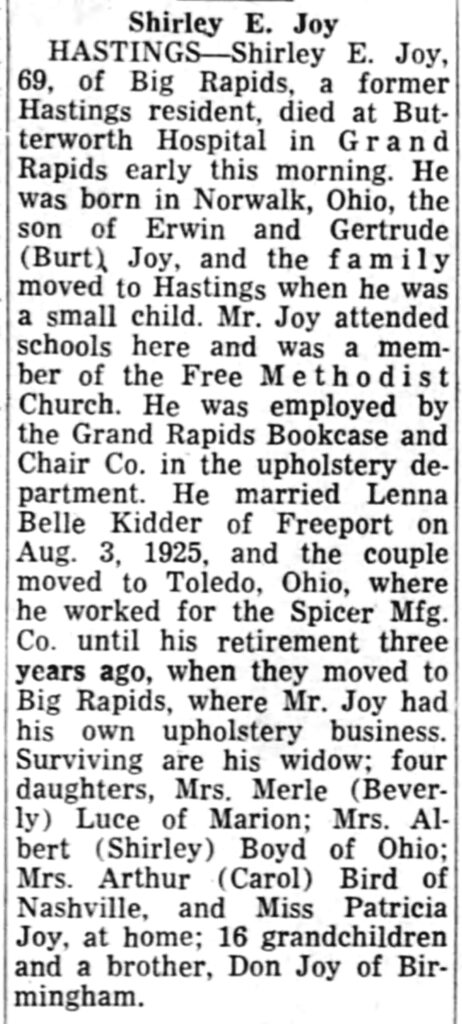
Shirley Ann Joy 1933-2006 (Maternal Grandmother)

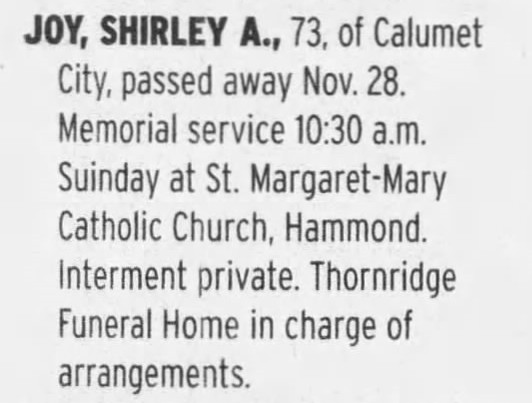
RESOURCES
Books and Boston Records:
Thomas Joy and his descendants in the lines of his sons Samuel of Boston, Joseph of Hingham, Ephraim of Berwick; a portfolio of family papers, comp. by James Richard Joy (1900)
A Brief History Of The Joy Family By One Of Them by Cornelia C. Joy Dyer (1876)
English Ancestry and Royal Descent of the Joy Family of America By A. A. G · 2018
The Joy Genealogy by Lee, Helen Bourne Joy, 1896-1977
The Story of the Old Boston Town House, 1658-1711 by Josiah Henry Benton (1908)
Re-dedication of the Old State House, Boston, July 11, 1882
History of the Military Company of the Massachusetts, Now Called the Ancient and Honorable Artillery Company of Massachusetts. 1637-1888 By Oliver Ayer Roberts · 1901
History of the Town of Hingham, Massachusetts, Charles Winfield Scott Seymour
The History and Antiquities of Boston, the Capital of Massachusetts and Metropolis of New England From Its Settlement in 1630, to the Year 1770
by Samuel G. Drake (1856)
Records Relating to the Early History of Boston by Boston (Mass.). Registry Department (1878)
History of Boston by Caleb Snow (2009)
The Book of Boston Fifty Years’ Recollections of the New England Metropolis by Edwin Monroe Bacon (1916)
List of Officers and Members, Including Pedigrees and a Record of the Services Performed by Ancestors in the Wars of the Colonies 1906
Magnalia Christi Americana Or, The Ecclesiastical History of New England By Cotton Mather · 1970
Proceedings of the Bostonian Society, Annual Meeting Volumes 1-8 By Bostonian Society · 1887
A Report of the Record Commissioners of the City of Boston: 1881, Boston records, 1660- 1701.
Documents of the City of Boston By Boston (Mass.). City Council · 1881
The Crooked & Narrow Streets of the Town of Boston 1630-1822
by Annie Haven Thwing, 1920.
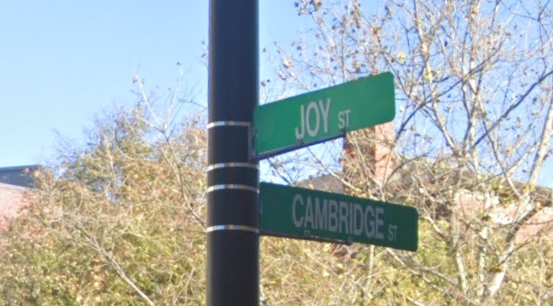
FIN
